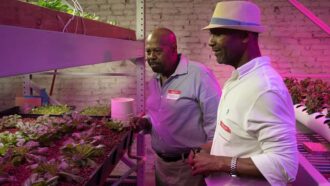Good Life Growing is an urban farm with a public service mission in North Saint Louis, Missouri. It uses a combination of aquaponic, hydroponic, aeroponic, and other sustainable farming methods to grow a variety of produce including microgreens, salad greens, and tomatoes. As a community-based organization, its broader goals address community revitalization and food insecurity in North Saint Louis.
In 2019, they received a $25,736 SARE Farmer Rancher grant to use a 2,000 sq. ft. section of indoor space to work with Urban Space Farms, Saint Louis Indoor Produce, and other community partners to create a modular, vertical aquaponic growing system and host educational programming.
“We intend to prove that formerly vacant property can be converted into thriving, sustainable, food-producing hubs capable of feeding the masses and creating living-wage jobs,” said James Forbes of Good Growing Life.
Building a DIY Urban Farm Aquaponics System
“We wanted to create a modular, vertical Aquaponic Growing Rack System that can produce a broad range of vegetables, an edible fish source that doubles as the nutrient supply, and innovative LED lighting technology that is energy efficient while putting out high-density lighting capable of mimicking the sun,” said Forbes.
After looking at a variety of commercially available systems, the team developed a 4’x10’x8’ grow rack system (pictured above right) using materials available from bulk ag suppliers, pallet rack manufacturers, and local hardware stores. For $1,000, they were able to achieve a system of similar size and scale to commercial systems that were 300% more expensive.
“The advantage of implementing our project was identifying the best ways of producing an inexpensive, high-performance aquaponic system and being able to share the designs with the general public,” said Forbes.
They designed their grow system to optimize the production of lettuce, spinach, and kale (high-demand products in their market).
- Volumes varied depending on type of crop, but per month they calculated roughly 1.5 lbs. of product per cubic square foot was produced ($10 per cubic square foot monthly for their market).
- They developed cloud-connected software that allows them to gather and store data from their systems. This software is open source and is readily accessible to the public via their SARE report (linked on the right).
Advancing Quality of Life
“The biggest success story from this project has been the relationships we formed,” said Forbes. “While this project was designed for the masses to benefit from across the country, it was a dream come true to see so many economically challenged participants sign up and complete the educational program.
Good Life Growing has reached more than 100 urban farmers, rural producers, novice horticulturalists, and experienced academics with their educational programming and tours. They have also employed 12 of the participants who completed affiliated programming through their project, as well several interns from St. Louis University who were tour participants.
View Related SARE Grant:
- North St. Louis Riverfront "GreenCubator" (fnc19-1162)
